Hudson Commodore
| Hudson Commodore | |
|---|---|
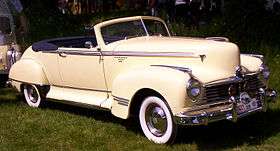 1947 Hudson Commodore Convertible Brougham | |
| Overview | |
| Manufacturer | Hudson Motor Car Company |
| Production |
1941-1942 1946-1952 |
| Assembly | Detroit, Michigan, United States |
| Body and chassis | |
| Class | Full-size |
| Layout | FR layout |
The Hudson Commodore is an automobile which was produced by the Hudson Motor Car Company of Detroit, Michigan between 1941 and 1952. During its time in production, the Commodore was the largest and most luxurious Hudson model.
First generation
| First generation | |
|---|---|
|
| |
| Overview | |
| Production | 1941-1942 |
| Body and chassis | |
| Body style |
2-door coupe 4-door sedan 2-door convertible |
| Powertrain | |
| Engine |
202 cu in (3.3 L) I6 254.4 cu in (4.2 L) I8 |
| Dimensions | |
| Wheelbase |
121 in (3,073 mm)[1] Custom sedan: 128 in (3,251 mm) |
1941
The Commodore and the Commodore Custom names debuted in Hudson's 1941 model line. Commodore models rode exclusively on the 121-inch (3,073 mm) wheelbase, while Commodore Customs rode either on the company's 121 in (3,073 mm) wheelbase for coupes, or 128 in (3,251 mm) for sedans. The Commodore was powered by Hudson's 202 cu in (3.3 L) I6 producing 102 bhp (76 kW), or by Hudson's 254.4 cu in (4.2 L) I8 that produced 128 bhp (95 kW).
The Commodore series was Hudson's largest model range in its debut year, consisting of sedans, coupes, and convertibles. Hudson used a forward hinged hood that opened from the rear by the windshield with the front end of the hood sliding downward over the grille. Elements of the interior and exterior were styled by Betty Thatcher, "the first woman designer to be employed by a car manufacturer".[2]
1942
For 1942, the cars received a facelift. This included concealed running boards, modestly enlarged front grilles, and external trim arrangements. Hudson offered an optional "Drive-Master" vacuum assisted clutch and servo-operated transmission with three modes: "automatic" shifting and clutching, automated clutching only, or fully manual.[3]
The firm promoted its economy over luxury during the shortened model year that ended in January, 1942, as U.S. war production accelerated.
Second generation
| Second generation | |
|---|---|
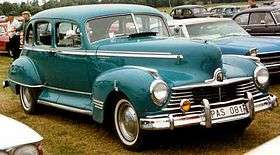 1947 Hudson Commodore Four Door Sedan | |
| Overview | |
| Production | 1946-1947 |
| Body and chassis | |
| Body style |
2-door coupe 4-door sedan 2-door convertible 2-door pickup |
1946
Hudson began its postwar automobile production on August 30, 1945. Body styles were trimmed to Sedan, Club Coupe, and Convertible. The designs were based on the 1942 models.[4] There were minor cosmetic changes from the pre-war versions with one exception, the car's grille now had a concave center section.
Hudson automobiles were more fully equipped than competitive makes, and all Hudson models received door arm rests, twin air-horns, ashtrays, windshield wipers, stop lights, locking glove box, sealed beam headlights, and deep pile carpeting. Commodore and Commodore Customs added foam rubber seat cushions (Hudson was the first automaker to introduce foam seat cushions), door-step courtesy lights, rear arm rest (sedans) and gold etched lettering on the dash board panel.
1947
Production of the 1947 Hudson Commodore Eight increased to 12,593 from the previous year's 8,193.[4]
Third generation
| Third generation | |
|---|---|
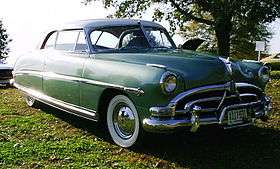 | |
| Overview | |
| Production | 1948-1952 |
| Body and chassis | |
| Body style |
2-door coupe 4-door sedan 2-door convertible |
1948
Introduced in December 1947, the Hudson Commodore was one of the first new-design postwar cars made.[5] The 1948 model year inaugurated Hudson's trademarked "Monobuilt" construction or "step-down" automobile. The new models were designed by Frank Spring.
The cars had a light, but strong semi-unit body with a perimeter frame. Because of the encircling frame, passengers stepped down into the vehicles. Hudson's step-down design made the body lower than contemporary cars. It offered passengers the safety of being surrounded by the car's chassis with a lower center of gravity. In addition to the added safety of being surrounded by the car's chassis, the step-down also allowed Hudson to gain weight savings provided through unibody construction, making for a well-performing automobile. The cars featured slab-sided bodies with fully integrated fenders. Brougham and sedans were fastbacks while convertibles and coupes were notchbacks. A character line ran from the front to back further lowering the car even more visually, so "the new Hudson looked like a dream car straight from the auto show."[6]
In 1948, Commodores came in one series, and were available in either I8 or I6 power. Interiors were upholstered in broadcloth on sedans, leather on convertibles. Again, Hudson continued to provide numerous standard features that other manufacturers classified as upcharge options. Commodore Eight production rose to 35,315 units.
1949

For 1949, the Commodore line was enlarged to include more luxurious Custom models. As a marketing promotion, Hudson had plastic specialists use scaled-down blueprints to develop transparent models of the Commodore Eight sedan to demonstrate and promote the design and construction of the cars.[7]
1950
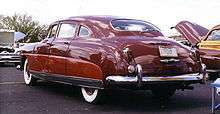
There were only nominal trim changes on the exterior of the cars in successive model years. A new a Custom Commodore convertible model debuted in mid-April 1950.
1951
In 1951, Hudson introduced a new I6 engine and offered General Motors' Hydra-Matic as an optional transmission.
1952
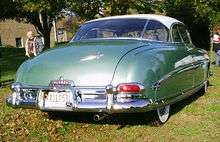
In its final year in 1952, the Commodore was split into a Six series and an Eight series. The exterior received another trim change, but by the end of 1953, the Step-Down styling was beginning to look outdated. Instead of redesigning the senior Hudsons, company President A. E. Barit pushed ahead with the firm's plan for the Jet compact.
Beginning in 1953, Hudson would field only the Hudson Hornet and Hudson Wasp line, and introduce the ill-fated Hudson Jet compact car line.
1957 showcar
Following Hudson's merger with Nash to form American Motors Corporation (AMC) in 1954, Hudson automobile production was switched to AMC's facility in Kenosha, Wisconsin. Following a weak 1955 model year, AMC chose to hand over the Hudson styling contract to Richard Arbib, who created a unique look for the Hudson line based on what he termed as "V-Line" styling. The move failed to attract new customers to Hudson, and production fell beneath the brand's disastrous 1955 model year product.
In its final year, the Hudson brand was pared down to a single model, the Hudson Hornet in two trim levels, the top-level Custom and the Super. However, during the show car season, AMC issued a one-off 1957 Hudson Commodore show car that was identical to the production Hornet, but featured gold exterior trim and special upholstery.
References
- Inline
- ↑ http://www.oldcarbrochures.com/static/NA/Hudson/1942_Hudson/1942_Hudson_Brochure/1942%20Hudson-05.html
- ↑ "Collection in Action - H". Franschhoek Motor Museum, South Africa.
- ↑ Auto Editors of Consumer Guide (16 September 2007). "1942 Hudson". howstuffworks com. Retrieved 3 September 2010.
- 1 2 Auto Editors of Consumer Guide (20 July 2007). "1946-1947 Hudson Commodore Eight". howstuffworks com. Retrieved 3 September 2010.
- ↑ Neely, William, John Lamm (1975). Cars to remember: thirty-seven great automobiles in retrospect. Regnery. p. 71. ISBN 978-0-8092-8241-8.
- ↑ Flory, J. Kelly (2008). American Cars, 1946-1959: Every Model, Year by Year. McFarland. p. 153. ISBN 978-0-7864-3229-5.
- ↑ "Model Cars Built on Production Line". Popular Science. 154 (1): 192. January 1949. Retrieved 3 September 2010.
- General
- Gunnell, John, ed. (1987). The Standard Catalog of American Cars 1946-1975. Krause Publications. ISBN 978-0-87341-096-0.
- Conde, John A. (1987). The American Motors Family Album. American Motors Corporation. OCLC 3185581.
External links
| Wikimedia Commons has media related to Hudson Commodore. |
- Hudson-Essex-Terraplane Club
- "Hudson Car Club" Hudson enthusiast site at Classiccar
- Hudson-Essex-Terraplane Historical Society
- Hudson Commodore in movies and TV series